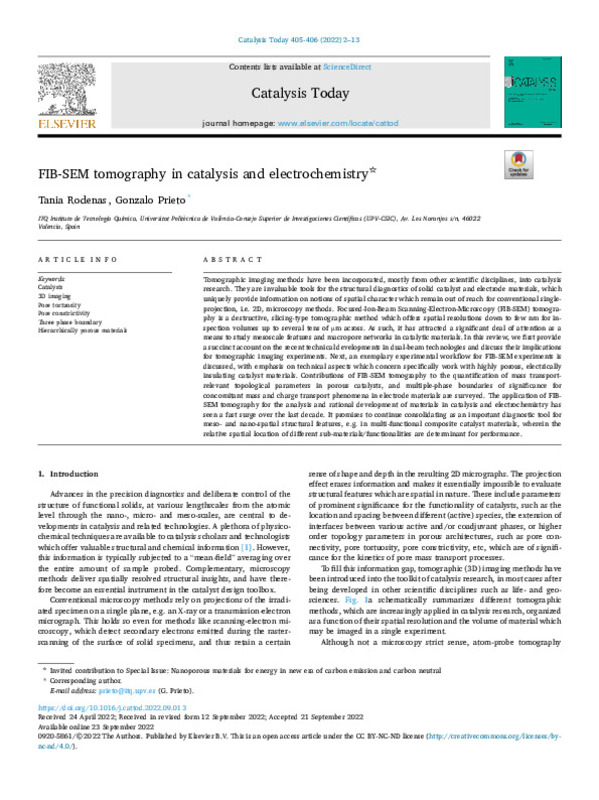JavaScript is disabled for your browser. Some features of this site may not work without it.
Buscar en RiuNet
Listar
Mi cuenta
Estadísticas
Ayuda RiuNet
Admin. UPV
FIB-SEM tomography in catalysis and electrochemistry
Mostrar el registro sencillo del ítem
Ficheros en el ítem
| dc.contributor.author | Ródenas Torralba, Tania
|
es_ES |
| dc.contributor.author | Prieto González, Gonzalo
|
es_ES |
| dc.date.accessioned | 2023-06-23T18:02:12Z | |
| dc.date.available | 2023-06-23T18:02:12Z | |
| dc.date.issued | 2022-12-01 | es_ES |
| dc.identifier.issn | 0920-5861 | es_ES |
| dc.identifier.uri | http://hdl.handle.net/10251/194520 | |
| dc.description.abstract | [EN] Tomographic imaging methods have been incorporated, mostly from other scientific disciplines, into catalysis research. They are invaluable tools for the structural diagnostics of solid catalyst and electrode materials, which uniquely provide information on notions of spatial character which remain out of reach for conventional singleprojection, i.e. 2D, microscopy methods. Focused-Ion-Beam Scanning-Electron-Microscopy (FIB-SEM) tomography is a destructive, slicing-type tomographic method which offers spatial resolutions down to few nm for inspection volumes up to several tens of mu m across. As such, it has attracted a significant deal of attention as a means to study mesoscale features and macropore networks in catalytic materials. In this review, we first provide a succinct account on the recent technical developments in dual-beam technologies and discuss their implications for tomographic imaging experiments. Next, an exemplary experimental workflow for FIB-SEM experiments is discussed, with emphasis on technical aspects which concern specifically work with highly porous, electrically insulating catalyst materials. Contributions of FIB-SEM tomography to the quantification of mass transportrelevant topological parameters in porous catalysts, and multiple-phase boundaries of significance for concomitant mass and charge transport phenomena in electrode materials are surveyed. The application of FIBSEM tomography for the analysis and rational development of materials in catalysis and electrochemistry has seen a fast surge over the last decade. It promises to continue consolidating as an important diagnostic tool for meso- and nano-spatial structural features, e.g. in multi-functional composite catalyst materials, wherein the relative spatial location of different sub-materials/functionalities are determinant for performance. | es_ES |
| dc.description.sponsorship | Authors acknowledge funding from the European Research Council (ERC-2019-COG 864195, TANDEng) . Staff members at the Electron Microscopy Service unit of the UPV are gratefully acknowledged for equipment maintenance and technical assistance. | es_ES |
| dc.language | Inglés | es_ES |
| dc.publisher | Elsevier | es_ES |
| dc.relation.ispartof | Catalysis Today | es_ES |
| dc.rights | Reconocimiento - No comercial - Sin obra derivada (by-nc-nd) | es_ES |
| dc.subject | Catalysts | es_ES |
| dc.subject | 3D imaging | es_ES |
| dc.subject | Pore tortuosity | es_ES |
| dc.subject | Pore constrictivity | es_ES |
| dc.subject | Three phase boundary | es_ES |
| dc.subject | Hierarchically porous materials | es_ES |
| dc.title | FIB-SEM tomography in catalysis and electrochemistry | es_ES |
| dc.type | Artículo | es_ES |
| dc.identifier.doi | 10.1016/j.cattod.2022.09.013 | es_ES |
| dc.relation.projectID | info:eu-repo/grantAgreement/EC/H2020/864195/EU | es_ES |
| dc.rights.accessRights | Abierto | es_ES |
| dc.description.bibliographicCitation | Ródenas Torralba, T.; Prieto González, G. (2022). FIB-SEM tomography in catalysis and electrochemistry. Catalysis Today. 405:2-13. https://doi.org/10.1016/j.cattod.2022.09.013 | es_ES |
| dc.description.accrualMethod | S | es_ES |
| dc.relation.publisherversion | https://doi.org/10.1016/j.cattod.2022.09.013 | es_ES |
| dc.description.upvformatpinicio | 2 | es_ES |
| dc.description.upvformatpfin | 13 | es_ES |
| dc.type.version | info:eu-repo/semantics/publishedVersion | es_ES |
| dc.description.volume | 405 | es_ES |
| dc.relation.pasarela | S\489648 | es_ES |
| dc.contributor.funder | European Research Council | es_ES |
| dc.contributor.funder | Universitat Politècnica de València | es_ES |








